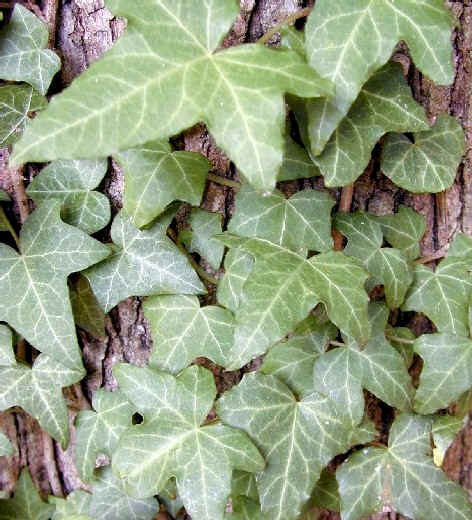| Hedera Helix | |
|
English Ivy
|
|
| Origin Of Species | |
| Europe, Western Asia, and Northern Africa | |
| Physical Description | |
| English ivy is an evergreen trailing or climbing vine that can reach up to a foot in diameter. The leaves are dark green and form an alternating arrangement along the stem. They are distinctly three-lobed with a heart-shaped base. Small clusters of greenish-white flowers appear in the fall in sufficient sunlight. Small black fruits are present in the spring. | |
| Habitat And Distribution | |
| English ivy is most predominately seen growing up trees and buildings. It may be present in woodlands, forest edges, fields, hedgerows, coastal areas, salt marsh edges, and other upland areas where soil moisture is prominent. It is often cultivated as an ornamental landscape plant for wall and ground cover. English ivy does not grow well in very wet conditions, and is often associated with land disturbances. It is found in at least thirty states along the western, southern, and eastern edges of the United States. | |
| Location On Campus | |
| English ivy is extremely abundant on campus, intentionally cultivated in the Westhampton Deanery Garden, around the quad between Jepson and Ryland Halls, on the brick walls flanking the driveway at the Presidentís residence, along the sign at the corner of College Road and Campus Drive, and various other locations. It is spreading out of control in Westhampton Woods near the Westhampton Gate, along the ravine on the eastern campus boundary (along Gateway Road), and in the ravines between the football practice fields and the Modlin Center. | |
| Negative Impacts | |
| English ivy is somewhat toxic, inducing vomiting, diarrhea, nervous conditions, and dermatitis, which ensures the spread of seeds by native birds that are attracted to the black berries. English ivy is an aggressive invader that may grow along the ground and into forest canopies, forming thick clusters of leaves that shade out sunlight from other plants. Its added weight on trees makes them susceptible to damage from storms. | |
| VDCR Invasiveness Ranking | |
| Moderately Invasive Species Additional Images: Vine on tree Leaves on ground Flowers |
|
